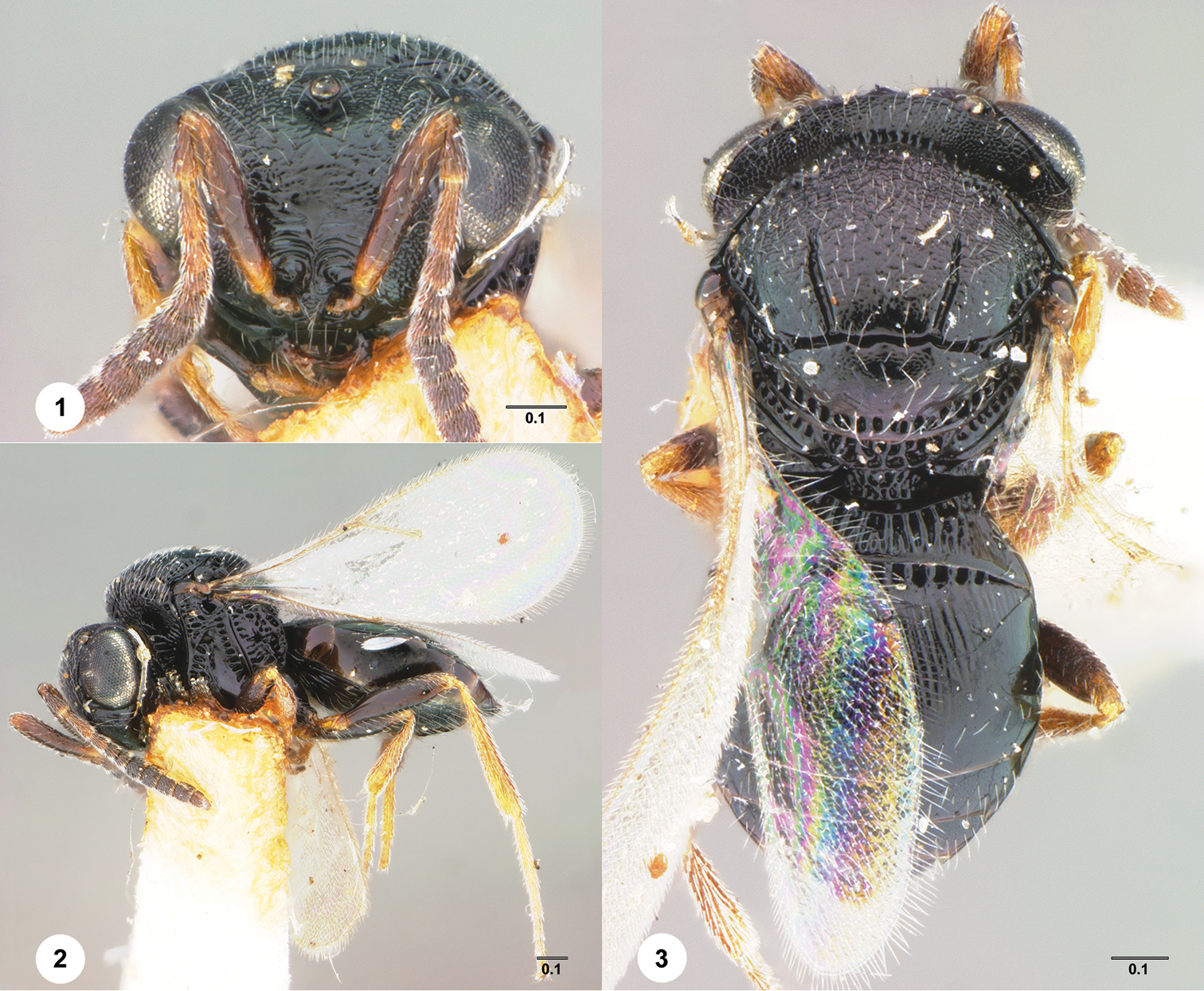






(C) 2013 Elijah J. Talamas. This is an open access article distributed under the terms of the Creative Commons Attribution License 3.0 (CC-BY), which permits unrestricted use, distribution, and reproduction in any medium, provided the original author and source are credited.
For reference, use of the paginated PDF or printed version of this article is recommended.
Citation: Talamas EJ, Buffington M, Hoelmer K (2013) New Synonymy of Trissolcus halyomorphae Yang. Journal of Hymenoptera Research 33: 113–117. doi: 10.3897/JHR.33.5627
Trissolcus halyomorphae Yang syn. n. is treated as a junior synonym following examination of the holotype of Trissolcus japonicus (Ashmead).
Halyomorpha halys, Trissolcus japonicus, Trissolcus halyomorphae, brown marmorated stink bug
Halyomorpha halys (Stål) (Hemiptera: Pentatomidae), commonly called the brown marmorated stink bug, is a polyphagous invasive pest in the Mid-Atlantic United States and is recorded from 39 of the 48 contiguous states (Carter and Hoebeke 2003,
Examination of the holotype of Trissolcus japonicus revealed that the characters attributed to this species by
Numerous attempts to borrow the holotype of Trissolcus halyomorphae were unsuccessful but we did procure two paratype females. These specimens, coupled with the images and description of Yang et al., enable us to confidently treat Trissolcus halyomorphae as a junior synonym of Trissolcus japonicus. We present this synonymy as a prelude to a full scale taxonomic revision of the Asian species of Trissolcus and to minimize confusion by eliminating future use of the name Trissolcus halyomorphae in literature regarding the biology of this species and its efficacy as a biological control agent.
The contributions of the authors are as follows: E.J. Talamas: species concept development, imaging, manuscript preparation; M. Buffington: manuscript preparation; K. Hoelmer: acquisition of paratype specimens.
The locality data reported for primary types are not literal transcriptions of the labels: some abbreviations are expanded; additional data from the collectors are also included. The numbers prefixed with “USNM ENT” or “USNM Type No.” are unique identifiers for the individual specimens (note the blank space after the acronyms). Details on the data associated with these specimens may be accessed at the following link, purl.oclc.org/NET/hymenoptera/hol, and entering the identifier in the form. The taxonomic synopsis was generated by the Hymenoptera Online Database (hol.osu.edu).
Images were produced using Combine ZP and Cartograph extended-focus software. Full resolution images are archived at the image database at The Ohio State University (purl.oclc.org/NET/hymenoptera/specimage), MorphBank (www.morphbank.net), and Hymenoptera Holotypes of the Smithsonian Institution (usnmhymtypes.com).
urn:lsid:biosci.ohio-state.edu:osuc_concepts:3249
http://species-id.net/wiki/Trissolcus_japonicus
Holotype, female, Dissolcus japonicus: JAPAN: Kanagawa Pref., Ashigarashimo Dist., Hakone Town, Koebele, USNM Type No. 7127 (deposited in USNM). Other material: 2 paratype females of Trissolcus halyomorphae, CHINA: Xiangshan, Beijing 7-VIII-2001, reared from eggs of Halyomorpha halys, Yang, Z.-Q. Leg. USNM ENT 00872401-00872402 (USNM)
Trissolcus japonicus, holotype female (usnm type no. 7127) 1 Head, anterior view 2 lateral habitus 3 dorsal habitus. Scale bars in millimeters.
1 urn:lsid:biosci.ohio_state.edu:osuc_pubs:97
2 urn:lsid:biosci.ohio_state.edu:osuc_pubs:944
3 urn:lsid:biosci.ohio_state.edu:osuc_pubs:310
4 urn:lsid:biosci.ohio_state.edu:osuc_pubs:602
5 urn:lsid:biosci.ohio_state.edu:osuc_pubs:688
6 urn:lsid:biosci.ohio_state.edu:osuc_pubs:326
7 urn:lsid:biosci.ohio_state.edu:osuc_pubs:364
8 urn:lsid:biosci.ohio_state.edu:osuc_pubs:1029
9 urn:lsid:biosci.ohio_state.edu:osuc_pubs:597
10 urn:lsid:biosci.ohio_state.edu:osuc_pubs:312
11 urn:lsid:biosci.ohio_state.edu:osuc_pubs:558
12 urn:lsid:biosci.ohio_state.edu:osuc_pubs:616
13 doi: 10.1603/008.102.0104
14 doi: 10.1371/journal.pone.0031246
